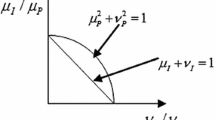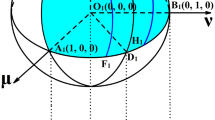Abstract
We introduce the idea of level sets which are crisp sets associated with a fuzzy set. We show how we can represent a fuzzy set using a collection of level sets; this allows us to extend set functions, such as probability and other set measures, to fuzzy subsets. We emphasize that this extension is itself a fuzzy subset. We next introduce Pythagorean fuzzy subsets and discuss the OWA and Choquet aggregation of these sets. We provide a formulation for level sets associated with a Pythagorean fuzzy subset that we use to provide a representation of a Pythagorean fuzzy set in terms of level sets. With the aid of Zadeh’s extension principle, we use this level set representation to provide for an extension of set measures to Pythagorean fuzzy sets. We then suggest an alternative approach to extending set measures to Pythagorean fuzzy sets using the Choquet integral.

Similar content being viewed by others
References
Zadeh, L.A.: Fuzzy sets. Inf. Control 8, 338–353 (1965)
Atanassov, K.T.: Intuitionistic fuzzy sets. Fuzzy Sets Syst. 20, 87–96 (1986)
Atanassov, K.T.: Intuitionistic Fuzzy Sets. Springer, Heidelberg (1999)
Yager, R.R., Abbasov, A.M.: Pythagorean membership grades, complex numbers and decision-making. Int. J. Intell. Syst. 28, 436–452 (2013)
Yager, R.R.: Pythagorean membership grades in multi-criteria decision making. IEEE Trans. Fuzzy Syst. 22, 958–965 (2014)
Zadeh, L.A.: Theory of fuzzy sets. In: Holzman, A.G. (ed.) Operations Research Support Methodology, pp. 569–606. Marcel Dekker, New York (1979)
Walker, C. L., Walker, E. A., Yager, R. R.: Some comments on level sets of fuzzy sets. In: Proceedings of World Congress on Computational Intelligence, Hong Kong, pp. 1227–1230 (2008)
Zadeh, L.A.: Similarity relations and fuzzy orderings. Inf. Sci. 3, 177–200 (1971)
Zadeh, L.: The concept of a linguistic variable and its application to approximate reasoning: Part 1. Inf. Sci. 8, 199–249 (1975)
Yager, R.R.: A characterization of the extension principle. Fuzzy Sets Syst. 18, 205–217 (1986)
Yager, R.R.: Level sets and the extension principle for interval valued fuzzy sets and its application to uncertainty. Inf. Sci. 178, 3565–3576 (2008)
Klement, E.P., Mesiar, R., Pap, E.: Triangular Norms. Kluwer Academic Publishers, Dordrecht (2000)
Xu, Y., Kerre, E.E., Ruan, D., Song, Z.: Fuzzy reasoning based on the extension principle. Int. J. Intell. Syst. 16, 469–495 (2001)
Sugeno, M.: Fuzzy measures and fuzzy integrals: a survey. In: Gupta, M.M., Saridis, G.N., Gaines, B.R. (eds.) Fuzzy Automata and Decision Process, pp. 89–102. North-Holland Pub, Amsterdam (1977)
Wang, Z.Y., Klir, G.J.: Fuzzy Measure Theory. Plenum Press, New York (1992)
Wang, Z., Klir, G.J.: Generalized Measure Theory. Springer, New York (2009)
Codd, E.F.: A relational model of data for large shared data banks. Commun. ACM 13, 377–387 (1970)
Petry, F.E.: Fuzzy Databases Principles and Applications. Kluwer, Boston (1996)
Eckstein, J., Schneider, S.L.: Introductory Relational Database Design for Business, with Microsoft Access. Wiley, Newark (2018)
Date, C.J.: “Database Design and Relational Theory. O’Reilly Media, Sebastopol (2012)
Atanassov, K.T.: On Intuitionistic Fuzzy Sets Theory. Springer, Heidelberg (2012)
Beliakov, G., Pradera, A., Calvo, T.: Aggregation Functions: A Guide for Practitioners. Springer, Heidelberg (2007)
Yager, R.R.: Criteria aggregations functions using fuzzy measures and the Choquet integral. Int. J. Fuzzy Syst. 1, 96–112 (1999)
Klement, E.P., Mesiar, R., Pap, E.: A universal integral as common frame for Choquet and Sugeno. IEEE Trans. Fuzzy Syst. 18, 178–187 (2010)
Yager, R.R.: On ordered weighted averaging aggregation operators in multi-criteria decision making. IEEE Trans. Syst. Man Cybern. 18, 183–190 (1988)
Yager, R.R.: OWA aggregation of multi-criteria with mixed uncertain satisfactions. Inf. Sci. 417, 88–95 (2017)
Yager, R.R.: A note on probabilities of fuzzy events. Inf. Sci. 18, 113–129 (1979)
Zadeh, L.A.: Probability measures of fuzzy events. J. Math. Anal. Appl. 10, 421–427 (1968)
Author information
Authors and Affiliations
Corresponding author
Rights and permissions
About this article
Cite this article
Yager, R.R. Extending Set Measures to Pythagorean Fuzzy Sets. Int. J. Fuzzy Syst. 21, 343–354 (2019). https://doi.org/10.1007/s40815-018-0580-6
Received:
Revised:
Accepted:
Published:
Issue Date:
DOI: https://doi.org/10.1007/s40815-018-0580-6




